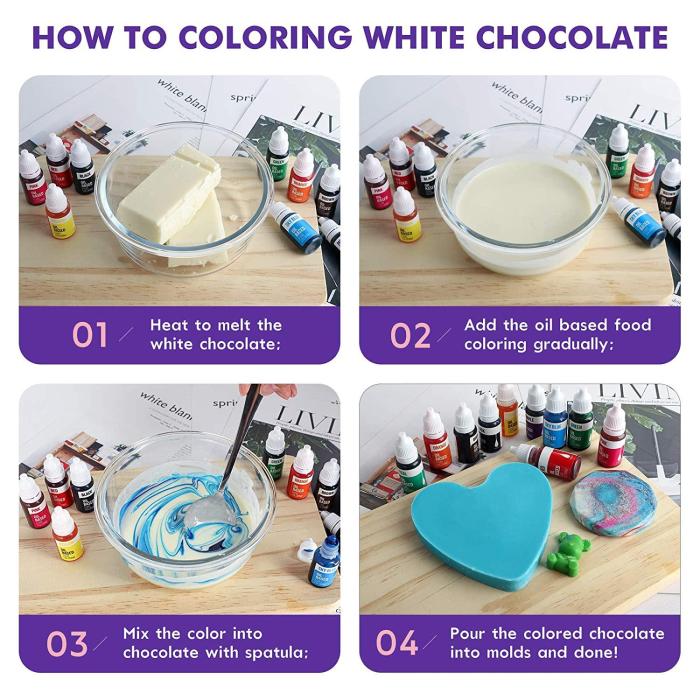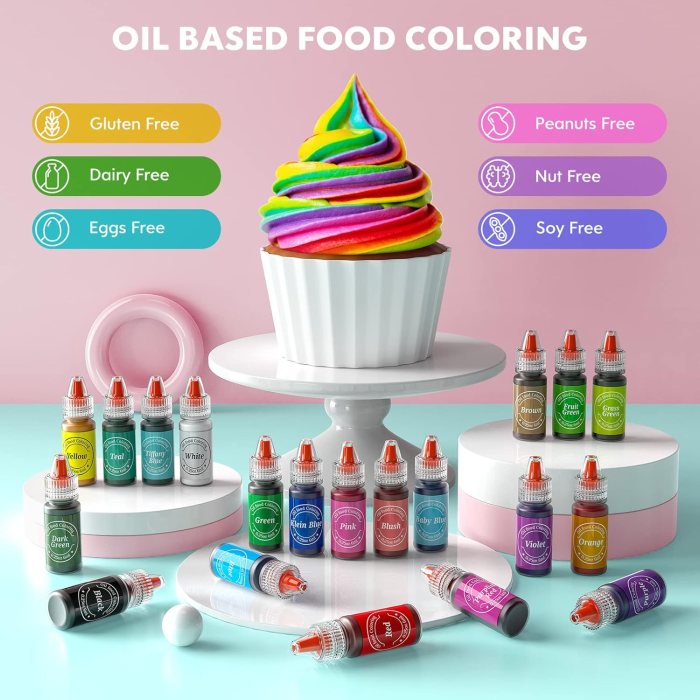Types of Oil-Based Food Coloring
Oil based food coloring for chocolate – Oil-based food colorings are a chocolatier’s secret weapon, adding vibrant hues and intense color saturation to their creations. Unlike water-based counterparts, they don’t cause that dreaded seizing in your precious chocolate. But the world of oil-based colorants is surprisingly diverse, each with its own personality and quirks. Let’s dive into the delicious details.
Types of Oil-Based Food Colorings Suitable for Chocolate, Oil based food coloring for chocolate
Several types of oil-based food colorings are specifically designed for use with chocolate and other fat-based products. Their compatibility with fats ensures even distribution and prevents issues like clumping or discoloration.
Here are five examples, each with its unique characteristics:
- Oil-soluble powder pigments: These are finely ground pigments suspended in an oil base, offering excellent color intensity and a wide range of shades. They’re often preferred for their ease of use and consistent color payoff.
- Liquid oil-based food coloring: These are pre-mixed solutions of pigments dissolved in an edible oil, providing a convenient and ready-to-use option. They often offer a more intense color than powders.
- Natural oil-based food colorings: Derived from natural sources like annatto (for yellow-orange), turmeric (for yellow), and beta-carotene (for orange), these offer a healthier alternative, although their color intensity might be slightly less vibrant than synthetic options.
- Cocoa butter-based colorings: These are specifically formulated with cocoa butter as the base, ensuring seamless integration into chocolate without altering its texture or flavor significantly. They’re a favorite among high-end chocolatiers.
- Concentrated oil-soluble pastes: These are highly pigmented pastes offering exceptional color intensity. A little goes a long way, making them economical despite their higher initial cost. They are perfect for achieving bold, saturated colors.
Color Intensity and Vibrancy in Different Chocolates
The intensity and vibrancy of oil-based food coloring can vary depending on the type of chocolate used. Dark chocolate, with its deep brown base, tends to mute brighter colors slightly. Milk chocolate provides a more balanced canvas, allowing colors to shine through with a softer, more approachable tone. White chocolate, being the lightest, offers the most vibrant and intense color display.
Think of it as a blank canvas for your colorful masterpieces!
Manufacturing Processes of Two Common Oil-Based Food Colorings
Let’s peek behind the curtain and explore the creation of two common oil-based food colorings:
1. Oil-soluble powder pigments: The manufacturing process typically involves finely milling pigments (like titanium dioxide for white, iron oxides for browns and reds, etc.) and then dispersing them in a suitable edible oil (like sunflower or soybean oil) using high-shear mixing equipment. This ensures the pigments are evenly distributed and remain suspended in the oil. The resulting mixture is then dried and ground into a fine powder.
Think of it as a microscopic dance of pigment and oil, resulting in a beautifully colored powder.
2. Liquid oil-based food colorings: The process is simpler. Pigments are dissolved directly into an edible oil using heat and mixing, creating a homogenous solution. The precise ratios of pigment to oil are carefully controlled to achieve the desired color intensity and stability. This method is similar to making a really intense, edible paint, but much more precise and food-safe.
Comparison of Three Selected Oil-Based Food Colorings
Here’s a table comparing three oil-based food colorings – oil-soluble powder pigments, liquid oil-based colorings, and cocoa butter-based colorings:
| Property | Oil-Soluble Powder Pigments | Liquid Oil-Based Colorings | Cocoa Butter-Based Colorings |
|---|---|---|---|
| Solubility in Chocolate | Excellent | Excellent | Exceptional |
| Color Stability (shelf life) | Good (with proper storage) | Moderate (prone to fading with prolonged exposure to light) | Excellent |
| Potential Interactions with Chocolate | Minimal | Minimal | None (seamless integration) |
Safety and Regulations

Let’s get serious for a moment, folks. While oil-based food coloring can make your chocolates look like a Jackson Pollock masterpiece, there are some crucial safety aspects to consider. We’re not talking about accidentally creating a chocolate-covered oil slick here (though that would be visually interesting, albeit messy). We’re talking about food safety regulations and responsible handling.Oil-based food colorings, while generally safe when used correctly, present some unique challenges compared to their water-based counterparts.
Their inherent oiliness can interact differently with chocolate, affecting texture and potentially posing safety risks if not handled with care. This section will explore those risks, the regulations designed to mitigate them, and best practices to keep your chocolate creations safe and delicious.
Potential Safety Concerns
The primary safety concern with oil-based food coloring in chocolate revolves around the potential for the coloring to not fully incorporate into the chocolate, leading to uneven distribution or even visible oil droplets. This can impact the texture and visual appeal of the final product. Furthermore, certain oil-based colorings might contain components that, while approved for use in food, could interact negatively with specific chocolate ingredients or trigger allergic reactions in sensitive individuals if not used as directed.
Always check the manufacturer’s guidelines and ingredient list meticulously. Another, less common but still important, concern is the possibility of using an oil-based coloring that is not food-grade, leading to serious health issues.
Relevant Food Safety Regulations and Standards
Food safety regulations regarding oil-based food colorings vary by country and region. Generally, these regulations specify allowable colorants, purity standards, and maximum usage levels. In the United States, the Food and Drug Administration (FDA) sets these standards, ensuring that approved colorants are safe for consumption. Similar regulatory bodies exist in other countries, like the European Food Safety Authority (EFSA) in the European Union.
These organizations conduct thorough testing and risk assessments before approving any food coloring for use. Non-compliance with these regulations can result in significant penalties, including product recalls and legal action. Always ensure your chosen oil-based food coloring is compliant with the regulations of your region.
Best Practices for Handling and Storage
Proper handling and storage are paramount to maintaining the quality and safety of oil-based food colorings. Store them in a cool, dark, and dry place, away from direct sunlight and extreme temperatures. This prevents degradation of the color and potential spoilage. Always use clean and sanitized utensils when handling the coloring to avoid contamination. Ensure that the containers are tightly sealed after each use to prevent oxidation and maintain the color’s vibrancy.
Furthermore, it’s crucial to follow the manufacturer’s instructions for usage and dilution, as improper handling can lead to uneven distribution or safety issues. Discard any coloring that shows signs of spoilage, such as discoloration, unusual odor, or changes in consistency.
Safe Handling and Usage Flowchart
Imagine a flowchart, a visual guide to safe chocolate-coloring adventures. It would start with “Obtain Food-Grade Oil-Based Coloring,” proceed to “Check for Compliance with Local Regulations,” then branch to “Proper Storage (Cool, Dark, Dry).” The next step would be “Sanitize Utensils,” followed by “Accurate Measurement and Mixing,” and finally “Thorough Incorporation into Chocolate.” A final box would state “Inspect for Uniformity and Safety.” This flowchart serves as a visual reminder of the sequential steps necessary for safe and effective use of oil-based food coloring.
Each step is a checkpoint ensuring the safety and quality of the final product. Deviation from this sequence could lead to problems.
Achieving vibrant hues in your chocolate creations? Oil-based food coloring is your secret weapon for intense, richly saturated colors that won’t dull your chocolate’s delicious shine. For a truly dazzling red, consider the intensity you can achieve with a high-quality red 40 food coloring , though remember to always test your color beforehand. Ultimately, the right oil-based food coloring will transform your chocolate masterpieces into edible works of art.
Alternatives and Comparisons: Oil Based Food Coloring For Chocolate

Choosing the right food coloring for your chocolate creations can feel like navigating a Willy Wonka-esque factory of sugary surprises. Oil-based food coloring offers a unique set of advantages and disadvantages compared to its water-based and powder counterparts, especially when working with the delicate world of chocolate. Let’s delve into the delicious details.Oil-based food colorings, with their vibrant hues and fat-soluble nature, integrate seamlessly into chocolate’s rich, oily embrace.
This creates a smooth, consistent color throughout the confection, avoiding the dreaded streaking or separation often associated with other coloring methods. However, this advantage comes with a trade-off; the intensity of the color might be slightly less vibrant than with water-based counterparts, and achieving extremely pale shades can prove more challenging.
Oil-Based vs. Water-Based Food Coloring in Chocolate
Water-based food colorings, while readily available and easy to use, can cause problems when added to chocolate. The water molecules in the dye clash with the fat molecules in the chocolate, leading to a grainy texture, uneven coloring, and a potential for the chocolate to seize up (think a chocolatey disaster!). Imagine a beautiful chocolate ganache, only to have it ruined by unsightly streaks of color.
Oil-based food coloring, on the other hand, avoids this issue due to its fat-soluble nature. The result is a beautifully colored, smooth chocolate, devoid of those unsightly water-based mishaps. The color integration is smoother and more even, leading to a more professional-looking final product.
Oil-Based vs. Powder Food Coloring in Chocolate
Powder food colorings, while versatile, require careful handling in chocolate. Their intense pigmentation means a little goes a long way, but improper incorporation can lead to unsightly clumps or uneven color distribution. This is especially true with darker chocolates, where the powder’s color may not blend as seamlessly. Oil-based colorings, by contrast, are pre-mixed and ready to go, offering a more straightforward application process with less potential for mess-ups.
While powder can offer intense color payoff, oil-based offers a more user-friendly experience for chocolate applications.
Examples of Recipes Utilizing Oil-Based Food Coloring in Chocolate
Let’s get our hands dirty (or rather, our spatulas)! A classic example is using oil-based food coloring in a chocolate ganache. The rich, creamy texture of the ganache perfectly complements the smooth integration of the oil-based dye, resulting in a vibrantly colored filling for truffles or cakes. Another fantastic application is in creating colored chocolate bark. The even distribution of the color allows for stunning visual effects, making it ideal for gift-giving or festive occasions.
Imagine a deep ruby red chocolate bark, speckled with vibrant green and gold—all thanks to the magic of oil-based food coloring.
Visual Differences in Final Product Appearance
Imagine two batches of chocolate truffles: one made with water-based coloring and one with oil-based. The water-based truffle might exhibit subtle, yet noticeable, streaking or a slightly grainy texture. The color itself may appear less uniform, with some areas appearing more intensely colored than others. In contrast, the oil-based truffle would boast a smooth, even color distribution, a glossy finish, and an overall more polished appearance.
The color would appear richer and more integrated, a testament to the harmonious blend of oil and chocolate. This difference in texture and color consistency is a clear visual indicator of the advantages of using oil-based food coloring in chocolate applications.
FAQ Guide
Can I use oil-based food coloring in all types of chocolate?
While generally suitable for most chocolates, the best results are achieved with dark chocolate due to its naturally rich base. Milk and white chocolate may require slightly more careful blending to achieve even color distribution.
How long does oil-based food coloring last?
Properly stored in a cool, dark place, oil-based food colorings can maintain their vibrancy for several months to a year. Always check the manufacturer’s instructions for specific shelf life information.
Are there any potential health concerns with using oil-based food coloring?
High-quality, food-grade oil-based colorings are generally safe for consumption. However, always source your colorings from reputable suppliers and adhere to recommended usage levels.
How do I clean up spills of oil-based food coloring?
Oil-based food coloring can be challenging to clean. Act quickly. Use a mild detergent and warm water. For stubborn stains, consider a specialized stain remover.

